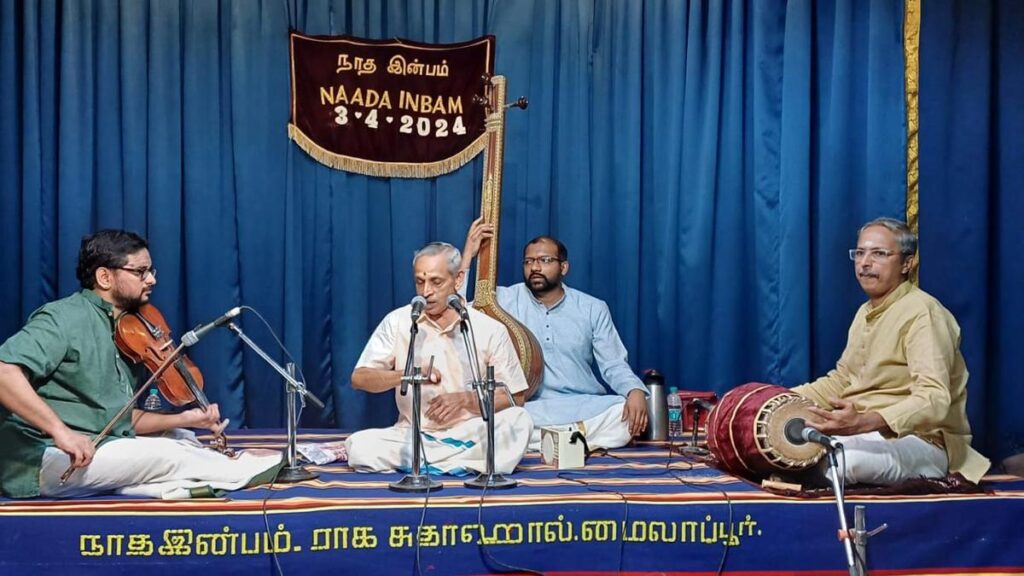The Carnatic vocalist presented a few slow-paced Muthuswami Dikshitar kritis at a concert in Chennai
The gravitas of Muthuswami Dikshitar’s compositions got its deserving focus when Thamarakkad Govindan Namboothiri best employed his solemn approach to his vocal concert at a special presentation in Chennai recently. Three unhurried kritis of the iconic composer was unveiled with textbook precision at Naada Inbam as part of the Andal and V. Ananathanarayanan memorial series, reinforcing the historical links Carnatic music has drawn from the ancient Dhrupad system.
Dikshitar (1776-1835) had spent seven years of his youth in north India, camping chiefly in Kashi and imbibing the essence of Hindustani classical. The meditative quality of Dhrupad caught his fancy, prompting the Sanskrit poet from the Cauvery delta region to pen slow-paced Carnatic kritis of structural splendour and spiritual value. These features come naturally to a research-oriented artiste such as Govindan, much like his late mentor Mavelikara Prabhakara Varma, also from Kerala.
Eclectic mix
At the Naada Inbam concert, Govindan rendered dissimilar ragas. None of the tala for the kriti would be repeated. The melodies at the opening and end were lighter vis-à-vis Kalyani as the centrepiece. Featuring niraval and tani avartanam, the Kamalambam package in the middle spanned a little over half of the 145-minute performance, with immaculate support from R. Raghul (violin) and K. Arunprakash (mridangam). While the violinist stuck to the sobriety of his guru M. Chandrasekaran, the percussionist contained his role to a measured minimum, akin to the pakhawaj in dhrupad.
Govindan began with Hindolam, which is rarely a kutcheri opener. The 12-minute alapana progressed largely with plain notes zigzagging upwards. The middle ranges covered the core of the janyaraga, though a pithier voice would have added to its character. Raghul’s solo response made up for that bit; he didn’t go overboard either. ‘Neerajakshi Kamakshi’ unfolded elegantly with the facade phrases bearing the prescribed cling-on quality. Into the last line of the charanam, the straight passages around ‘Sauri virinchi’ sparkled with Arunprakash’s string of sweet taps.
Sprightly Kalyani
The main suite, interestingly, warmed up comparatively quickly — maybe because Kalyani is innately sprightly. The alapana phrases were short, though its middle part did generate long-drawn notes. There were no frills attached, yet it never sounded like Yaman, the Hindustani equivalent of the 65th Melakarta. The violin toed a suitable line. Raghul was at ease even while being contemplative. Restraint was the key word, and so the top notes bore no shrill.
‘Kamalambam’ treaded gently along predictable paths. It was almost an extension of the alapana with words. At the start of the charanam, where ‘Sarvaasha paripuraka’ sounds closer to Yamunakalyani, Govindan’s sudden plunges resulted in several dramatic moments. They only displayed his strong adherence to the coaching manual. Niraval arrived seamlessly, initiating a grand build-up around ‘Nirvana nijasukha’. The swaraprastara carried enough strength; the tani avartanam in two-kalai Adi was crisp.
In conclusion came Manirangu, another derivative. After an alapana with more cuts than curves, ‘Mamava pattabhiramajaya’ in Mishra Chapu, inversely, had a fair share of slides — and ups too. The four minutes of swaras were delicate and patterned. Overall, the concert was like a yogic test for sustained concentration.

